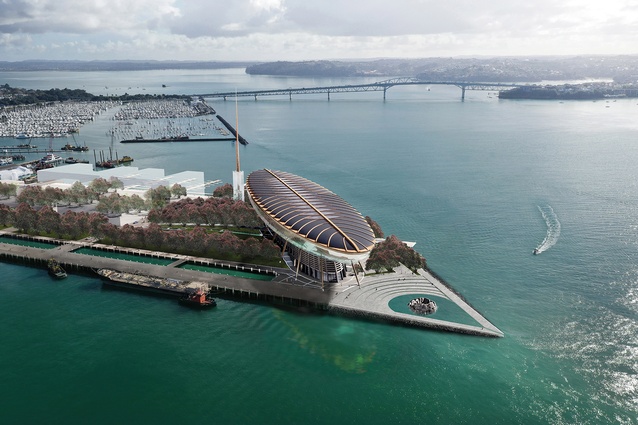Editorial: Chris Barton on complacency
“The whole world hardly needs more museums,” writes Dushko Bogunovich in a letter to The New Zealand Herald at the end of January. “One might cynically say the entire global civilization is on track to becoming a museum, considering our complacency over the threat of climate catastrophe”. Museum, as in a place where dead things are displayed, is quite a good image but wasteland, desert or underwater graveyard would also do. The former associate professor of Urban Design at Unitec School of Architecture and Landscape Architecture is spot on about the complacency.
Bogunovich was responding to a proposal conceived by Auckland environmental consultant Warwick Pascoe for an enormous ‘LegendNZ Centre’ on Auckland’s Wynyard Point. The waka-shaped timber building – 40,000sqm over five floors, which has no official status – is designed by Archimedia. It’s proposed as a museum to celebrate the stories of famous New Zealanders – heroes mainly from the worlds of adventure, sport and warfare.
That would also include ‘Kiwi Bravehearts’ – the stories of “our greatest soldiers from the Māori Wars through to Afghanistan”, Pascoe told the Herald. Which prompted columnist Brian Rudman to snort: “The which wars? What colonial time warp have these guys been living in for the past fifty years?” To which he helpfully added: “Did none of these architects have sufficient grasp of history to know that the old British imperial habit of naming their wars of conquest after the people they invaded – Zulu Wars, Boer Wars, Indian Mutiny – was abandoned by New Zealand historians around half a century ago?” Oh dear.
Perhaps the cruellest blow was another letter unkindly saying the design “looks more like a cockroach” than some sort of boat. They do say these indestructible insects are likely to inherit the earth after we’ve wrecked it.
Bogunovich suggests a museum addressing precisely the complacency about the climate catastrophe might be a worthwhile endeavour – a ‘Museum of Humanity’s Future’. I do like Archimedia’s design for its biblical foreboding – with a little adaptative reuse, it could indeed float as a modern version of Noah’s ark, complete with solar panel-powered energy, hydroponic gardens and a DNA repository of all the world’s species. Booking cabins for passengers – who would make the cut? – could, however, be problematic. Every waterfront city should have one.
In the meantime, between now and catastrophe, what might be better named the ‘Museum of Head-in-the Sand Climate Change Complacency’ would have floors of exhibits devoted to just that: exposing half a century of an orchestrated litany of lies engineered by the fossil fuel companies, which have been aware of their damaging impact on the planet since at least the 1950s. And, of course, exhibits depicting the gullible media, which, even today, continues to promote climate science denialism as justified scepticism. Fake news. Donald Trump take a bow.
Look, for example, at the LegendNZ narrative and Bogunovich’s critique. Rather than take it seriously, Herald journalist Simon Wilson focuses on all the other unofficial plans for Auckland waterfront museums, including art consultant Hamish Keith’s 2011 glass box for a Te Papa North museum and Wilson’s own invention – Tangata Moana – “because we are the people of the sea and this is our story”.
To have any hope of turning this climate apocalypse around, journalists like Wilson need to stop banging on about mad grand designs and flights of fancy. And architects have to stop giving him ammunition. In December last year, Wilson gave his vision of what Auckland would be like in 30 years’ time. That included lots more really tall buildings. “The first tower block taller than the Sky Tower was topped off in 2031 and more have followed.” But this was all okay because they were green. “Greenery grows all over many buildings, playing an important role in helping to keep the air clean inside and out.”
Wilson has also been a huge fan of the completely bonkers sunken stadium idea by Peddle Thorp. Simon says: “The Crater got built, eventually. That sunken stadium idea from 2019 turned out to have a clever way of bracing itself against every storm, and the thrill of being inside, with the game locked up and lightning in the sky, has become one of the city’s great experiences.”
Then, Wilson wrote a paragraph that gets him his own exhibit in the Head-in-the-Sand museum. “Climate change batters Aotearoa as it batters everywhere but the country is luckier than most. Droughts, storms, floods and plagues of disease-carrying insects aside, the rising sea levels are not especially dangerous to the downtown city. Storm surges are dissipated by the islands of the Hauraki, and the sea walls built in the 2030s are doing their job.”
Sea walls? Will these run all along Tāmaki Drive and around the entire inner harbour? Perhaps in the 2030s, we build our version of the Thames barrier – a massive weir across the mouth of the Waitematā.
Since 2019, architects here and across the world have signed up to ‘Architects Declare’, acknowledging that buildings and construction account for nearly 40 per cent of energy-related carbon dioxide emissions. Efforts are now under way by some to reduce that damage. It’s not an easy task and the implications for architecture are far-reaching and difficult. Some architects are committing to building carbon neutral, building more with carbon sink materials and less with concrete and steel. It also means fewer tall buildings, always thinking first about the case for not demolishing existing buildings and, yes, probably not designing waterfront museums, unless they float.
This article first appeared in Architecture New Zealand magazine.











